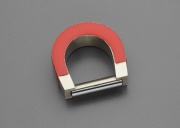Difference between revisions of "White gold"
m (Text replace - "== Authority ==" to "== Sources Checked for Data in Record ==") |
m (Text replace - "\[http:\/\/cameo\.mfa\.org\/materials\/fullrecord\.asp\?name=([^\s]+)\s(.*)\]" to "$2") |
||
| Line 2: | Line 2: | ||
== Description == | == Description == | ||
| − | A gold alloy that is whiter and tougher than pure [ | + | A gold alloy that is whiter and tougher than pure [[gold|gold]]. White gold is malleable, but must be worked evenly or it may crack. It is used as a substitute for [[platinum|platinum]] in jewelry, gilding, and decoration. Some compositions for white gold are: |
- Gold (18k) with 25% platinum (Untracht 1968) | - Gold (18k) with 25% platinum (Untracht 1968) | ||
| − | - Gold (18k) with 25% [ | + | - Gold (18k) with 25% [[palladium|palladium]] (soft white) |
| − | - Gold (18K) with 3.7% [ | + | - Gold (18K) with 3.7% [[copper|copper]], 16.3% [[nickel|nickel]], and 5% [[zinc|zinc]] (hard white) |
- Gold (18K) with 10-12% palladium, 8-10% nickel, and 2-9% zinc (Untracht 1968, Lewis 1993, Brady 1971, Hawley 1981) | - Gold (18K) with 10-12% palladium, 8-10% nickel, and 2-9% zinc (Untracht 1968, Lewis 1993, Brady 1971, Hawley 1981) | ||
| Line 20: | Line 20: | ||
- Gold with 20-50% nickel (Brady 1971) | - Gold with 20-50% nickel (Brady 1971) | ||
| − | Some formulations of white gold, particularly those made with nickel, are coated with [ | + | Some formulations of white gold, particularly those made with nickel, are coated with [[rhodium|rhodium]] to increase their luster. |
== Synonyms and Related Terms == | == Synonyms and Related Terms == | ||
Revision as of 12:17, 10 May 2016
Description
A gold alloy that is whiter and tougher than pure Gold. White gold is malleable, but must be worked evenly or it may crack. It is used as a substitute for Platinum in jewelry, gilding, and decoration. Some compositions for white gold are:
- Gold (18k) with 25% platinum (Untracht 1968)
- Gold (18k) with 25% Palladium (soft white)
- Gold (18K) with 3.7% Copper, 16.3% Nickel, and 5% Zinc (hard white)
- Gold (18K) with 10-12% palladium, 8-10% nickel, and 2-9% zinc (Untracht 1968, Lewis 1993, Brady 1971, Hawley 1981)
- Gold (14K) with 22.5% copper, 12% nickel, and 7% zinc
- Gold (10K) with 59% nickel (Lewis 1993)
- Gold (9K) with 28% copper, 17.5% nickel, 17% zinc (Brady 1971)
- Gold with 20-50% nickel (Brady 1971)
Some formulations of white gold, particularly those made with nickel, are coated with Rhodium to increase their luster.
Synonyms and Related Terms
Weißgold (Deut.); ouro branco (Port.)
Additional Information
° O. Untracht, Metal Techniques for Craftsmen, Doubleday and Co., Garden City, NY, 1968. ° G.S.Brady, Materials Handbook, 10th edition, McGraw-Hill, New York, 1971.° World Gold Council: Link
Sources Checked for Data in Record
- Matt Roberts, Don Etherington, Bookbinding and the Conservation of Books: a Dictionary of Descriptive Terminology, U.S. Government Printing Office, Washington DC, 1982
- A History of Technology, Charles Singer, E.J. Holmyard, A.R. Hall (eds.), Clarendon Press, Oxford, Volume 1: From Early times to Fall of Ancient Empires, 1954
- Oppi Untracht, Metal Techniques for Craftsmen, Doubleday & Company, Garden City, 1968
- Wikipedia, the free encyclopedia, at http://www.wikipedia.com Comment: http://en.wikipedia.org/wiki/White_gold (accessed Jan 2005)
- Thomas Gregory, The Condensed Chemical Dictionary, Reinhold Publishing, New York, 3rd ed., 1942
- G.S.Brady, Materials Handbook, McGraw-Hill Book Co., New York, 1971 Comment: p. 870
- Richard S. Lewis, Hawley's Condensed Chemical Dictionary, Van Nostrand Reinhold, New York, 10th ed., 1993
- Random House, Webster's Encyclopedic Unabridged Dictionary of the English Language, Grammercy Book, New York, 1997
- The American Heritage Dictionary or Encarta, via Microsoft Bookshelf 98, Microsoft Corp., 1998
